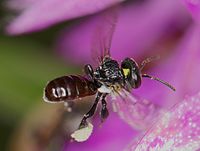
Photo from wikipedia
Simple Summary Perception of olfactory cues represents a core function of insects. They perceive these signals by small organs, termed as sensilla, mostly located on the antennae. Besides olfactory sensilla,… Click to show full abstract
Simple Summary Perception of olfactory cues represents a core function of insects. They perceive these signals by small organs, termed as sensilla, mostly located on the antennae. Besides olfactory sensilla, the antennae are also equipped with other types of sensilla involved in the perception of various cues (i.e., contact chemical, mechanical, physical). Through the integration of different stimuli from the environment, insects are able to interact dynamically with the biotic and abiotic components of the ecosystem. The ultrastructural characterization of sensilla allows for a specific function to be assigned to a specific type of sensilla, providing the base for further electrophysiological and ecological studies. In this work, we investigated the antennae of an important biocontrol agent of scale insects, Anagyrus vladimiri. The ultrastructural organization of the sensilla was investigated by scanning and transmission electron microscopy. We found eight different types of antennal sensilla, for which we proposed a specific functional hypothesis. Abstract The Encyrtidae (Hymenoptera) encompasses a large group of parasitic wasps widely used in biocontrol programs of scale insects (Hemiptera: Coccoidea). Anagyrus vladimiri is a solitary parasitoid that attacks and develops on several mealybugs of economic importance. Thus, this species is widely used as a biocontrol agent of Planococcus spp. and Pseudococcus spp. A. vladimiri males and females show sexual dimorphism with regard to the antennal organization, in terms of shape and the development of antennomeres. Ultrastructural investigations of female antennae, carried out with scanning (SEM) and transmission (TEM) electron microscopy, revealed the presence of nine distinct antennomeres. The scape was enlarged and paddle-like, compared to the other antennomeres. The club (the apical antennomere) was mono-segmented and housed the highest number of sensilla. Eight morphologically different types of sensilla were described; sensilla trichoidea I, trichoidea II, chaetica I, chaetica II, grooved peg sensilla, campaniform sensilla, multiporous plate sensilla and multiporous basiconic sensilla. Ultrastructural investigations allowed for us to assign a specific function to each type of sensilla. The most abundant type of sensilla were sensilla trichoidea I and multiporous plate sensilla. We also found two types of sensilla (multiporous basiconic sensilla and sensilla chaetica II) that were present only on the females.
Journal Title: Insects
Year Published: 2022
Link to full text (if available)
Share on Social Media: Sign Up to like & get
recommendations!